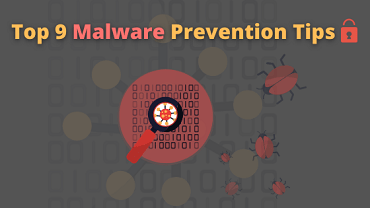How to Stay Away From Downloading Malware? Top 9 Prevention Tips
Web swarms with viruses and malware. The unaided eye often fails to spot a malicious code as its distributors conceal it using social engineering tricks and other techniques like drive-by-downloads and zero-click attacks. So, how do you secure your machine from new viruses and malware if you cannot detect it and antiviruses are not always reliable?
Tip 1 – Never Visit Unsafe Web Pages
Malicious code often originates from unsecured websites. Cybercriminals host their malware on their own websites and those they hacked earlier.
Avoid browsing potentially unsafe sites. For business, it is better to set this as a compulsory requirement in your standard operating procedures for staff members.
But how can you tell a safe website from an unsafe website? That is pretty easy. You do not have to be a cyber-security guru to check a website’s application layer protocol. For instance, https://forbes.com makes use of https://. It shows you that the website you open has an SSL certificate. SSL stands for Secure Socket Layer and means the website holding it is safe. Earlier http used to dominate the web; now, this type of protocol is dying out as it is not deemed safe anymore.
An SSL certificate is a bundle of two encryption keys. One is private, and the other is public. This pair ensures safe encrypted communication secured from third-party interference. SSL enables a trusted connection with the website concerned.
It is to be admitted that non-https pages do not necessarily host malicious code. Oppositely, an https page may prove to be unsafe. Such cases occur at an increasing frequency as malicious code evolves, producing more sophisticated strains like polymorphic viruses ever.
Tip 2 – DNS Filtering to Block Insecure Websites
Ensuring a website holds a valid SSL certificate is a good starting point. Now let us move on. Advanced traffic filtering at the level of DNS helps you protect both your endpoints and corporate networks from corrupted domains that pretend to be free of malicious code. I do not recommend any particular solution here. Just make sure a security tool you run features advanced content filtering.
A traditional antivirus in the world of evolving malware does not keep your machine secure. A modern security solution must provide the following functionality:
- Scan traffic using enhanced machine learning algorithms.
- Help avoid any exposure of restricted access data.
- Have comprehensive data filtering (DNS, HTTP, HTTPS).
- Secure network and endpoints from crypto viruses, exploits, APTs.
Tip 3 – Avoid Clicking Suspicious Web Links
Clicking unverified links is a common malware infection vector for most malware types, including dangerous ransomware viruses. Such links may trigger a download session that drops a malicious code into your machine.
So, how to prevent malicious downloads originating from compromised links? Never open a link until after inspecting the URL it points to. Fortunately, ensuring the link is safe is straightforward enough. Just hover over it with your mouse and check if the website name you see is true to the name the link declares. A malicious website URL may differ from the trusted one by a single symbol. Watch for different spelling and other minor deviations.
If you suspect anything bad, you can also verify the website’s URL with free online scanning tools like VirusTotal.
Tip 4 – Skip Free Apps
The only free cheese is in the mousetrap. Software available for free tends to be bundled with malicious code. Plenty of applications are free, and you can download such programs from their official websites without a second thought as long as you know their publisher is a trustworthy party. They do not sell licenses because they earn money by adding dubious tools to the installation files.
Next, have you ever stumbled upon a page distributing a paid app for free? Hackers also deploy email phishing attacks sending links to websites that allegedly offer paid software at no cost to users. Both offers lead to scams and malware.
Tip 5 – Ensure Incoming Emails Are Safe
Did you know that 85% of all organizations have been hit by phishing attacks? Spam messages that contain malicious content are a prevailing phishing tactic.
Attackers resort to advanced social engineering techniques to lure unwary users. Whether you follow a link, process content attached, provide any data by filling a form, or just reply to the email dispatched by the crooks; you are going to be pawned. Do not fall for any of these tricks as malware and viruses lurk behind the curtain.
A rule of thumb is to make every employee aware of phishing and its most widespread varieties. I strongly encourage security training to be provided at regular intervals. These activities should teach your staff how to tell a malspam and other phishing emails from safe items.
Tip 6 – Run and Regularly Update Enhanced Security Suite
Staff training is essential, but it is not the only measure to be applied. Engaging every employee in IT matters is a great move. Meanwhile, every member of your team is a professional in his limited area. Cybersecurity is not everyone’s strong point, and human error is always around. That is why your corporate cyber-security should make use of a modern email security suite. A solution I would subscribe to would feature an enhanced antispam capable of recognizing the latest malware strains with heuristic and signature-based scanning.
The importance of such protection can hardly be overestimated as emails you receive is a critical terminal point for entering your system. My ideal solution should include:
- In-depth email attachments and links scanning.
- Proactive protection against phishing, including targeted campaigns.
- Enhanced antispam shield repelling popular methods of spammers.
- Scam suppression functionality focused on preventing BEC campaigns.
A security system of my choice should alert its users about fraud attempts and email compromise in good time. This enables the early detection of deceptive messages and misleading statements.
Tip 7 – Keep ads at bay
Some ads are notorious for the extreme annoyance they produce. To make things worse, some ads you encounter carry a malicious script. Interacting with such ads exposes your operating system and network to malware attacks. Even though most ads pose no threat of malicious payload introduction, I strongly suggest blocking them on all workstations. This would reduce the distraction of your staff and ensure malware-backed ads do not infect your systems.
Popular web-browsers provide built-in functionality for popups and redirects suppression. Among specialized solutions in this niche, AdBlock Plus is my favorite. You would also appreciate that the app is free.
Tip 8 – Make use of all Patches Once Available
Too many people are inclined to ignore or postpone updates and patches available for the software they run. This habit is more dangerous than you may expect it to be. The risk is multiplying dramatically if it takes place in a vast business system.
Unpatched software is a common infection vector. 20 to 40 percent of breaches occur due to bugs in apps that users fail to address despite the availability of patches. Hackers often combine this vector with phishing. User clicks a malicious link, and malware exploits unpatched apps.
The burden of keeping software up-to-date and applying patches in time is too heavy for ordinary employees. An automated solution is much appreciated. Such a tool should be configured by the IT staff to install updates on the background immediately upon their release.
Tip 9 – Protect Your Environment With a Trusted Antivirus and Firewall
Computer viruses appeared more than 30 years ago. It took several years after the first virus attack for an antivirus solution to emerge. As its name suggests, the software is tasked with inspecting the computer system it is installed on to detect and remove computer viruses. A firewall restricts incoming contents by applying a set of filters.
A modern approach to combating malicious code suggests a combination of an antivirus and a firewall. This pair is basically what the concept of a next-generation antivirus (NGAV) refers to. An NGAV features advanced antivirus and firewall solutions.
Unlike old antiviruses, a new generation tool goes beyond signature-based detection. It excels in sandbox analysis, backdoor, and heuristic examination.
Steering clear of malware and viruses is all about your money and reputation. Best practices of safe browsing, email handling, DNS filtering, combined with enhanced security solutions reinforce your corporate cybersecurity.





